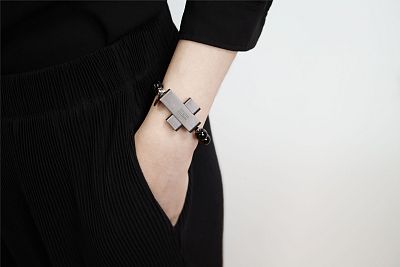Members of the Catholic Church who spoke to NBC News acknowledged that while not the most traditional offering, it did provide a new way for people to connect with God.
There's an ongoing conversation at the Dominican Monastery of Our Lady of the Rosary in New Jersey where Sister Mary Catharine hears it particularly with younger newcomers.
"I think the biggest change was smartphones because most of us don't need to have one, and we don't live off of it," she said. "Meanwhile, the rest of the world does."
But even those younger, more smartphone-friendly sisters were puzzled by the Vatican's newest effort to engage people — a rosary that can be paired with a smartphone to track everything from prayers offered to steps taken.
Sister Mary Catharine said she and the younger sisters had a similar reaction: "Why would anybody want to use something like that?"
In October, the Vatican introduced the "Click to Pray eRosary" smart device, a combination of a typical rosary and a Fitbit that can we worn around the wrist. Within the beads and black cross are sensors that can detect rotational motion, which can be paired with an app on a smartphone to track a variety of stats, both religious and secular.
Members of the Catholic Church who spoke to NBC News offered mixed reactions to the device, acknowledging that while not the most traditional offering, it did provide a new way for people to connect with God.
David Spesia, executive director of the secretariat of evangelization and catechesis for the United States Conference of Catholic Bishops, said that there is a possible downside with this type of "gamification" of prayer but that it can also provide people with this built-in accountability.
"If the goal remains helping them actually pray the rosary and reflect on the life of Jesus through the eyes of Mary, right on," Spesia said.
While prayer and spirituality aren't typically associated with the distracting, material world of technology, religious leaders for nearly a century have been using it to connect with more worshippers. "If this machine were the work of the devil, how could it possibly carry the words of the Quran?" modern Saudi Arabia's founder Idn Saud said in 1925 as he read a passage of the Quran into a microphone to make the case for telegraphy and telephony in the country.
Over the last several decades, religious texts and guided prayer have been made available through online services, apps and digital archives. The Vatican has offered its own entries, including a confessional app, as well as a pope-centric app.
Father James Martin, the editor-at-large at the Jesuit magazine America Media and a priest working on a book about prayer, said that the rosary is the most popular physical object in the Catholic church in companion to prayer, making it a predictable candidate for a wearable. He said that an eRosary is a natural next step in the modernization of prayer given all of the current prayer apps and podcasts, as well as the fact that we're all spending an increasing amount of time on our smartphones.
"This is basically going where people are, which is what Jesus did. Jesus went where people were," Martin said. "For a younger generation, they don't have that hang-up, they are perfectly comfortable living online, and if they are living online, that's where the church can find them."
Finding people is a reasonably new challenge for the Catholic Church. Child sex abuse by Catholic priests and other scandals among Catholic leadership and a broad decline in church attendance have eaten away at the church's once-prominent place in America's religious and social fabric. Polling company Gallup found in April that while church membership in the United States has declined broadly, the drop among Catholics outpaced Protestants.
Both Martin and Sister Mary Catharine brought up the price point — €99 or about $110 — and the fact that you also need a smartphone to access all of eRosary's features, as potentially disenfranchising for a large part of the population.
So far, the eRosary does not appear particularly popular. Its app has been downloaded around 17,000 times since its launch, mostly in Italy and Portugal, according to data from app-tracking company Apptopia.
"One of the things that the Holy Father and the church in general is trying to really push is greater simplicity and less materialism and more sensitivity to the poor, to people who are struggling," Sister Mary Catharine said. "But then you turn around and say to a young person who has a ton of debt, 'Hey, spend $110 on this thing.'"
Martin said that it's important to be mindful when developing these types of smart prayer products that they don't shut out the poor, and that those who are praying the old-fashioned way, with a physical set of analog rosary beads, "don't feel left out or don't feel like they're somehow not as holy."
The overall sentiment on the eRosary was that, in concept, using technology to connect with more people at a time when the world is more and more online isn't inherently bad.
"Anything that can lead a person closer to God is valuable in my estimation," Martin said.












